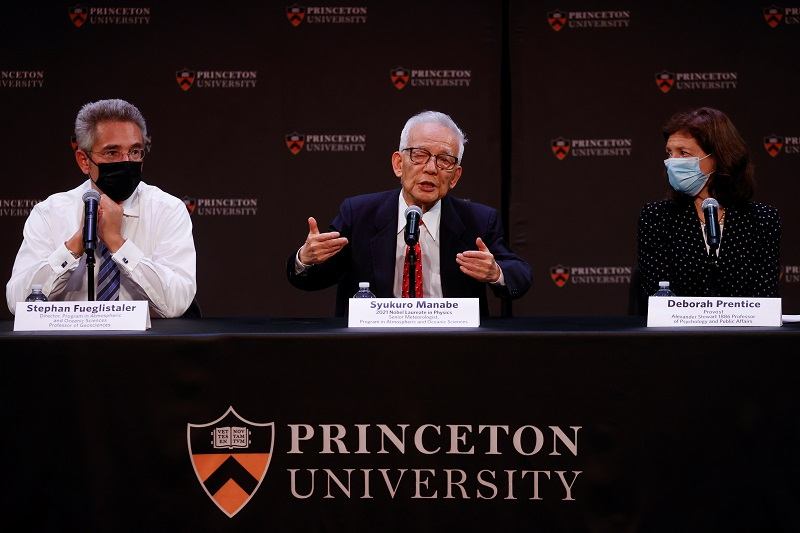
Princeton University meteorologist Professor Syukuro Manabe, who won a share of the 2021 Nobel Prize in physics, attends a press conference alongside Stephan Fueglistaler and Deborah Prentice at the university in Princeton, New Jersey, U.S., October 5, 2021.
18:59 JST, October 6, 2021
Syukuro Manabe, 90, a senior meteorologist at Princeton University who won the 2021 Nobel Prize in Physics, laid the foundation for the computerized prediction of global climate change.
The U.N. Intergovernmental Panel on Climate Change (IPCC), in its climate report released in August, stated unequivocally that human activities have an impact on global warming. At the foundation of this statement are Manabe’s research achievements, which have contributed greatly to the international debate on Earth’s changing climate.
Untrodden field
At a press conference following the announcement of Manabe and two other scientists as this year’s physics laureates, a Royal Swedish Academy of Sciences official said that climate models are analyses solidly based on physics theory and that the concept of global warming rests on a firm scientific foundation. He emphasized that this is a message to world leaders.
Skepticism has smoldered for many years regarding the impact of human activities on global warming. The awarding of the prize to these three scientists signifies that the debate on the causes of global warming has been settled scientifically. The academy praised the trio’s achievements, saying that they have contributed to the greatest benefit for humankind.
Manabe moved to the United States in 1958, shortly after he obtained a doctoral degree in Japan, and joined a team of researchers developing methods to calculate climate change with computers at the then U.S. Weather Bureau.
In calculating Earth’s changing climate, researchers deal with complex physical systems, such as air temperatures and the amount of water vapor in the air, all of which require a massive volume of data processing. Even in the United States, where the development of high-speed computers had advanced, it was an untrodden field of research.
Human impact
Manabe’s first remarkable achievement was a paper, published in 1967, concerning air temperatures in different parts of the atmosphere. Visualizing the atmosphere as a “column” of air extending from the ground to high into the sky, he established methods of calculating the relationship between solar radiation, air movements and temperature changes. In the troposphere — from the ground up to an altitude of 10 or more kilometers — temperatures fall as altitude rises. But in the stratosphere, above the troposphere, temperatures rise again. He reproduced this climate model on a computer.
When he increased the amount of carbon dioxide in the computer model, his results showed that global warming would advance. “I did it casually, just to confirm the validity of the model,” Manabe recalled. But back then, there was no data showing the relationship between human activity and global warming, and his model drew attention around the world.
Toshio Yamagata, 73, an honorary professor at the University of Tokyo and a scholar on climate dynamics, praised Manabe’s foresight, saying, “The relationship between the concentration of CO2 and Earth’s climate had not drawn much attention back then.”
Surprise
Manabe further developed his climate model, and improved his prediction of global warming in 1989, by taking into account the interactions between the atmosphere, ocean and land surface. This climate model was incorporated into the First Assessment Report released by the IPCC in 1990.
Klaus Hasselmann, 89, a professor at the Max Planck Institute for Meteorology in Germany who shares the Nobel with Manabe, proved that climate models can be reliable.
When IPCC Working Group I released its Sixth Assessment Report in August, it asserted that the role of human influence on the climate system “is unequivocal.”
Seita Emori, 51, deputy director of the Earth System Division at Japan’s National Institute for Environmental Studies (NIES) who was among the authors of the Sixth Assessment Report, said, “His achievements in building climate models from scratch are great. What Mr. Manabe predicted has proved almost entirely correct.”
Previously, achievements in climatology did not seem to be within the scope of natural sciences likely to yield a Nobel Prize. NIES President Masahide Kimoto, 64, spoke with open delight when he said: “Our seniors used to tell us, ‘There will be no Nobel Prize winner in our field of study.’ This is a happy surprise.”
"Society" POPULAR ARTICLE
-

M4.9 Earthquake Hits Tokyo, Neighboring Prefectures
-

M7.5 Earthquake Hits Northern Japan; Tsunami Waves Observed in Hokkaido, Aomori and Iwate Prefectures
-

Israeli Tourists Refused Accommodation at Hotel in Japan’s Nagano Pref., Prompting Protest by Israeli Embassy and Probe by Prefecture
-

Tsukiji Market Urges Tourists to Avoid Visiting in Year-End
-

M5.7 Earthquake Hits Japan’s Kumamoto Pref., Measuring Upper 5 Intensity, No Tsunami Expected
JN ACCESS RANKING
-

Keidanren Chairman Yoshinobu Tsutsui Visits Kashiwazaki-Kariwa Nuclear Power Plant; Inspects New Emergency Safety System
-

Imports of Rare Earths from China Facing Delays, May Be Caused by Deterioration of Japan-China Relations
-

University of Tokyo Professor Discusses Japanese Economic Security in Interview Ahead of Forum
-

Japan Pulls out of Vietnam Nuclear Project, Complicating Hanoi’s Power Plans
-

Govt Aims to Expand NISA Program Lineup, Abolish Age Restriction


















